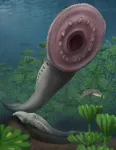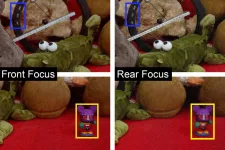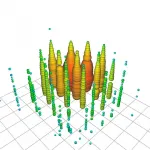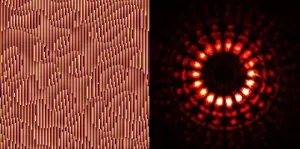(Press-News.org) Bone is not just a fixed material - it's a dynamic set of structures that can adapt their mass and strength based on the loads they must support.
Developing that sort of adaptive material has long been the dream of scientists. Now for the first time, scientists at the Pritzker School of Molecular Engineering (PME) at the University of Chicago have developed a gel material that strengthens when exposed to vibration.
Not only were scientists able to make the material 66 times stronger through vibrations, they were also able to strengthen only the areas exposed to movement. That sort of specificity could lead to new adhesives and better ways of integrating implants within the body.
The results were published February 22 in the journal Nature Materials.
"Every other material becomes weaker when vibrated," said Assoc. Prof. Aaron Esser-Kahn, who led the research. "This is the first time we have reversed that process, showing that a material can strengthen itself with mechanical vibration."
Forming a second network within the material
When Esser-Kahn and his group began thinking about how to develop adaptive materials, they looked to take advantage of the piezoelectric effect, which gives certain materials the ability to generate an electric charge in response to mechanical stress. Such a charge could instigate a reaction within a material and strengthen it, they proposed.
But generating the right response to mechanical stress proved tough. The team tested dozens of different chemistries before they found the one that worked: a polymer gel mixed with thiol-ene reactors and zinc oxide piezoelectric particles.
When the material is vibrated, the particles transduce energy and create a thiol-ene reaction, which causes the components in the material to cross link. That cross-linking essentially forms a second network inside the material, strengthening it.
Though the material started off as a soft, collagenous material, as the vibration increased, the material was strengthened further and further. The team was able to increase the strength of the material to 66 times its original strength, ending with a material that was close to the stiffness of the interior parts of bone.
"Just like bone, the material strengthened to the exact amount of power we put into it," Esser-Kahn said. Not only that, the material didn't just strengthen throughout - it selectively strengthened itself in specific areas where it was stressed to a higher degree.
Creating new kinds of adhesives that integrate with the body
That sort of selective strengthening could lead to materials that can selectively stiffen - and a new way to design structures. Perhaps it could become part of a building that gets stronger as it ages, or be used to adhere materials together in an airplane.
"Adhesives could be hugely influenced by this," Esser-Kahn said. "Adhesives are almost always the point of failure in materials. This could lead to specialized adhesives that adhere and set much better."
The group is examining how to use the material to better integrate artificial materials into the human body - in hip implants, for example.
"No two humans are alike, and a material like this is how we start making materials that behave the same as those found in biology," Esser-Kahn said.
INFORMATION:
Other authors on the paper include postdoctoral researchers Zhao Wang, Jun Wang, and Saikat Manna; graduate student Jorge Ayarza; former graduate researcher Tim Steeves; and Ziying Hu of Northwestern University.
Scientists have developed a see-through glass display with a high white light contrast ratio that smoothly transitions between a broad spectrum of colors when electrically charged. The technology, from researchers at Jilin University in Changchun, China, overcomes limitations of existing electrochromic devices by harnessing interactions between metal ions and ligands, opening the door for numerous future applications. The work appears March 10 in the journal Chem.
"We believe that the method behind this see-through, non-emissive display may accelerate the development of transparent, eye-friendly displays with improved readability for bright working conditions," says Yu-Mo Zhang, an associate professor of chemistry at Jilin ...
The cryptocurrency market has been abuzz as Bitcoin gains popularity with investors, reaching an all-time high of over $58,000 apiece in February. In a commentary published March 10 in the journal Joule, financial economist Alex de Vries quantifies how the surging Bitcoin price is driving increasing energy consumption, exacerbating the global shortage of chips, and even threatening international safety.
Theoretically, any computer with access to the internet and electricity can "mine" Bitcoin, a process to receive cryptocurrency by solving sophisticated mathematical equations. It is estimated that all miners combined make over 150 quintillion--that is 18 zeros following 150--attempts every second to solve the equation, according to numbers from January 11, 2021. Computational power ...
Scientists and healthcare providers are beginning to use a new approach for assessing a person's inherited risk for diseases like Type 2 diabetes, coronary heart disease and breast cancer, which involves calculating a END ...
When we think about the causes of neurological disorders and how to treat them, we think about targeting the brain. But is this the best or only way? Maybe not. New research by scientists at Baylor College of Medicine suggests that microbes in the gut may contribute to certain symptoms associated with complex neurological disorders. The findings, published in the journal Cell, also suggest that microbe-inspired therapies may one day help to treat them.
Dr. Mauro Costa-Mattioli, professor and Cullen Foundation Endowed Chair in neuroscience and director of the Memory and Brain Research Center at Baylor, discovered ...
Ottawa, March 10, 2021 - A new study of fossilized lampreys dating from more than 300 million years ago is challenging a long-held theory about the evolutionary origin of vertebrates (all animals with a backbone). The findings are published March 10 in the science journal Nature.
Lampreys are ancient, jawless, eel-like fishes that arose around half a billion years ago and they have long provided insights into vertebrate evolution. Now, scientists with the Canadian Museum of Nature, the University of Chicago and the Albany Museum in South Africa are reporting their analysis of dozens of tiny fossils that track the life stages and growth of ancient lampreys, from hatchlings to juveniles to adults.
Their results counter the established view that the blind, filter-feeding ...
A new study out of the University of Chicago, the Canadian Museum of Nature and the Albany Museum challenges a long-held hypothesis that the blind, filter-feeding larvae of modern lampreys are a holdover from the distant past, resembling the ancestors of all living vertebrates, including ourselves. The new fossil discoveries indicate that ancient lamprey hatchlings more closely resembled modern adult lampreys, and were completely unlike their modern larvae counterparts. The results were published on March 10 in Nature.
Lampreys -- unusual jawless, eel-like, creatures -- have long provided insights ...
Despite years of hype, virtual reality headsets have yet to topple TV or computer screens as the go-to devices for video viewing. One reason: VR can make users feel sick. Nausea and eye strain can result because VR creates an illusion of 3D viewing although the user is in fact staring at a fixed-distance 2D display. The solution for better 3D visualization could lie in a 60-year-old technology remade for the digital world: holograms.
Holograms deliver an exceptional representation of 3D world around us. Plus, they're beautiful. (Go ahead -- check out the holographic dove on your Visa card.) Holograms offer a shifting perspective based on the viewer's position, and they allow the eye to adjust focal depth to alternately focus on foreground and background.
Researchers have long sought ...
On December 6, 2016, a high-energy particle called an electron antineutrino hurtled to Earth from outer space at close to the speed of light carrying 6.3 petaelectronvolts (PeV) of energy. Deep inside the ice sheet at the South Pole, it smashed into an electron and produced a particle that quickly decayed into a shower of secondary particles. The interaction was captured by a massive telescope buried in the Antarctic glacier, the IceCube Neutrino Observatory.
IceCube had seen a Glashow resonance event, a phenomenon predicted by Nobel laureate physicist ...
Researchers have struck quantum gold--and created a new word--by enlisting machine learning to efficiently navigate a 20-dimensional quantum treasure map.
Physicist Dr Markus Rambach from the ARC Centre of Excellence for Engineered Quantum Systems (EQUS) at The University of Queensland said the team was able to find unknown quantum states more quickly and accurately, using a technique called self-guided tomography.
The team also introduced the 'quvigint', which is like a qubit (the quantum version of a classical bit that takes on the values '0' or '1') except that it takes on not two, but 20 possible values.
Dr ...
What The Study Did: In this study, most risk factors associated with SARS-CoV-2 infection among health care workers were outside the workplace.
Authors: Jesse T. Jacob, M.D., of Emory University in Atlanta, is the corresponding author.
To access the embargoed study: Visit our For The Media website at this link https://media.jamanetwork.com/
(doi:10.1001/jamanetworkopen.2021.1283)
Editor's Note: The article includes conflict of interest and funding/support disclosures. Please see the article for additional information, including other authors, author contributions and affiliations, conflict of interest and financial disclosures, and funding and support.
INFORMATION:
Media ...




